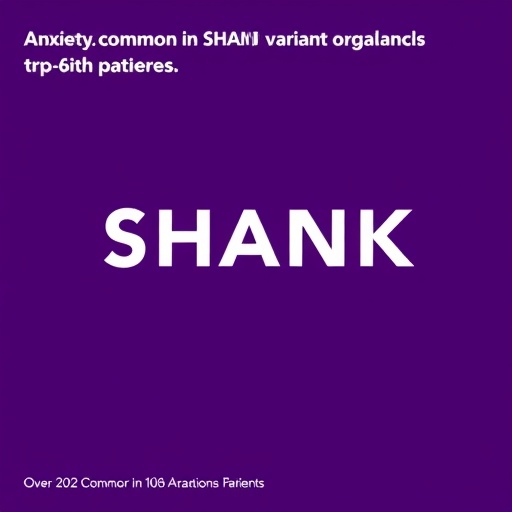In a compelling new study published in BMC Psychiatry, researchers have unveiled critical insights into the psychopathological landscape associated with pathogenic variants in the SHANK gene family. This investigation sheds light on the pressing clinical challenge of neuropsychiatric comorbidities in patients carrying mutations in SHANK1, SHANK2, and SHANK3 genes. By focusing on five newly identified cases, the study elucidates the phenotypic spectrum and highlights a particularly noteworthy association with anxiety disorders, a crucial step forwarding personalized medicine for affected individuals.
The SHANK gene family encodes for synaptic scaffolding proteins that are pivotal in the organization and function of excitatory synapses in the brain. Mutations in these genes have long been implicated in autism spectrum disorder (ASD), but their broader psychiatric and neurodevelopmental implications remain incompletely understood. The new findings contribute a substantial addition to the growing body of evidence that links SHANK pathogenic variants not only to ASD but also to complex psychiatric phenotypes including intellectual disabilities and anxiety disorders.
The study meticulously employed whole exome sequencing techniques, targeting 115 pediatric patients aged between 6 and 18 years who exhibited mild intellectual disability or borderline intellectual functioning alongside psychiatric comorbidities. Among this cohort, five patients were found to carry intragenic pathogenic variants disrupting SHANK1, SHANK2, and SHANK3 genes. The researchers then carried out a detailed characterization of their neurodevelopmental trajectories, clinical presentations, and psychopathological profiles, revealing both common and unique features across these cases.
One of the stark revelations was the universal presence of significant language and motor delays among the five cases. Such developmental delays highlight the foundational role that SHANK proteins may play not merely in synaptic architecture but also in broader neurodevelopmental processes that govern communication and motor skills. The early manifestation of these delays provides an important clinical marker for identifying potential SHANK-related disorders before full psychiatric comorbidity becomes apparent.
Neuropsychiatric evaluations further underscored autism spectrum disorder as the most frequent and prominent psychiatric diagnosis in these patients. However, what distinguishes this study is the recognition of generalized anxiety disorder (GAD) in four of the five individuals, alongside a non-specific anxiety disorder in the remaining patient. This observation posits anxiety disorders as a recurrent and critical comorbidity in the context of SHANK mutations, suggesting that anxiety-related symptomatology may be intrinsic to the pathophysiological mechanisms underlying these genetic alterations.
The implications of identifying generalized anxiety disorder alongside ASD in SHANK mutation carriers extend beyond clinical nosology; they hint at shared molecular pathways that might be disrupted in these conditions. Given the synaptic localization of SHANK proteins and their regulatory functions in excitatory synapses, it raises fascinating questions about how synaptic dysregulation can predispose individuals to both neurodevelopmental and anxiety disorders. This intersection invites future research combining genomic, neurophysiological, and behavioral approaches.
Additionally, the study’s emphasis on precise genetic diagnosis is a call to reshape clinical paradigms. Early detection of pathogenic SHANK variants can not only facilitate tailored therapeutic interventions but also enable families to receive accurate genetic counseling. This approach promises to reduce the diagnostic odyssey often experienced by patients with overlapping intellectual disabilities and psychiatric disorders, fostering a personalized medicine framework.
The research also serves to emphasize the heterogeneity within neurodevelopmental disorders, where a single gene family, such as SHANK, can manifest in diverse psychiatric and developmental phenotypes. This variability calls for comprehensive and multidisciplinary assessment strategies, integrating genetic, neuropsychological, and clinical data for improved patient management. It challenges clinicians to move beyond categorical diagnoses and toward understanding complex genetic contributions to mental health.
From a therapeutic standpoint, the identification of SHANK mutations as a common denominator in anxiety and ASD invites exploration into novel treatments targeting synaptic dysfunction. Pharmacological interventions modulating synaptic plasticity or correcting synaptic protein imbalances could represent future directions in treating patients with SHANK-related neuropsychiatric disorders. Moreover, behavioral therapies could be refined with a genetic understanding of symptom etiology, optimizing outcomes.
This study also raises an important awareness issue—neuropsychiatric disorders connected with SHANK mutations might be underdiagnosed due to symptom overlap with other developmental disabilities. By profiling specific genetic and clinical features, the paper advocates for enhanced screening protocols in psychiatric and neurodevelopmental clinics, particularly for children presenting with intellectual delays combined with anxiety or autism spectrum features.
Furthermore, the evidence presented champions the role of whole exome sequencing in pediatric neuropsychiatric diagnostics, reaffirming its potency as a tool for uncovering elusive genetic factors. Such molecular diagnostic advancements empower clinicians to stratify patients based on genetic etiology, which is essential for guiding targeted research, improving therapeutic design, and ultimately enhancing patient quality of life.
Overall, the study pioneers a more nuanced understanding of SHANK pathogenic variants by integrating neurodevelopmental, neuropsychiatric, and dysmorphological perspectives. It underscores the necessity for continued research on the molecular underpinnings and clinical implications of SHANK mutations, with the hope of elucidating mechanisms that drive neurodevelopmental and anxiety disorders. By doing so, it lays an exciting foundation for precision psychiatry tailored to genetic profiles.
In sum, this research amplifies the emerging narrative that anxiety disorders are not merely co-occurring phenomena but may be intrinsic components of the SHANK mutation phenotype. The findings open pathways toward improved diagnosis, genetic counseling, and targeted intervention strategies that could transform care for individuals with SHANK gene-related neuropsychiatric disorders. As science progresses, this work is poised to generate significant buzz in psychiatric genetics and neurodevelopmental research communities worldwide.
Subject of Research: Neuropsychiatric and neurodevelopmental features associated with pathogenic variants in SHANK family genes, with a focus on anxiety disorders.
Article Title: Anxiety disorder is a common psychopathological comorbidity in patients with SHANK pathogenic variants: description of five new cases.
Article References:
Manso-Bazus, C., Spataro, N., Plans, L. et al. Anxiety disorder is a common psychopathological comorbidity in patients with SHANK pathogenic variants: description of five new cases. BMC Psychiatry 25, 1074 (2025). https://doi.org/10.1186/s12888-025-07510-y
Image Credits: AI Generated
DOI: 10.1186/s12888-025-07510-y




